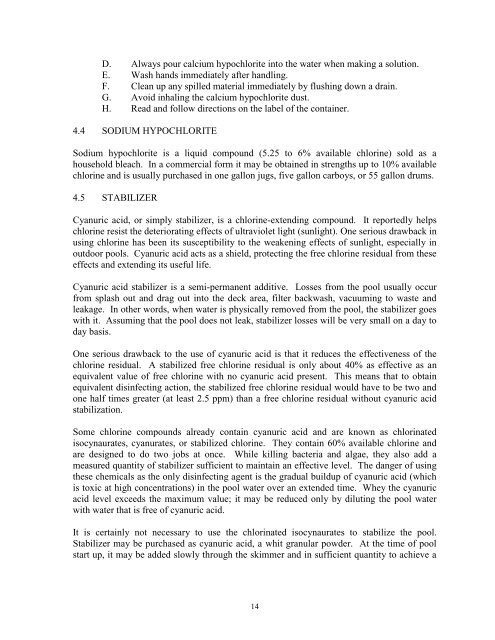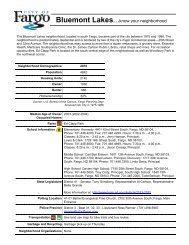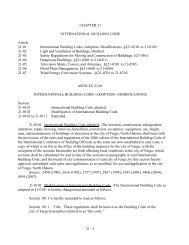Create successful ePaper yourself
Turn your PDF publications into a flip-book with our unique Google optimized e-Paper software.
D. Always pour calcium hypochlorite into the water when making a solution.E. Wash hands immediately after handling.F. Clean up any spilled material immediately by flushing down a drain.G. Avoid inhaling the calcium hypochlorite dust.H. Read and follow directions on the label <strong>of</strong> the container.4.4 SODIUM HYPOCHLORITESodium hypochlorite is a liquid compound (5.25 to 6% available chlorine) sold as ahousehold bleach. In a commercial form it may be obtained in strengths up to 10% availablechlorine and is usually purchased in one gallon jugs, five gallon carboys, or 55 gallon drums.4.5 STABILIZERCyanuric acid, or simply stabilizer, is a chlorine-extending compound. It reportedly helpschlorine resist the deteriorating effects <strong>of</strong> ultraviolet light (sunlight). One serious drawback inusing chlorine has been its susceptibility to the weakening effects <strong>of</strong> sunlight, especially inoutdoor pools. Cyanuric acid acts as a shield, protecting the free chlorine residual from theseeffects and extending its useful life.Cyanuric acid stabilizer is a semi-permanent additive. Losses from the pool usually occurfrom splash out and drag out into the deck area, filter backwash, vacuuming to waste andleakage. In other words, when water is physically removed from the pool, the stabilizer goeswith it. Assuming that the pool does not leak, stabilizer losses will be very small on a day today basis.One serious drawback to the use <strong>of</strong> cyanuric acid is that it reduces the effectiveness <strong>of</strong> thechlorine residual. A stabilized free chlorine residual is only about 40% as effective as anequivalent value <strong>of</strong> free chlorine with no cyanuric acid present. This means that to obtainequivalent disinfecting action, the stabilized free chlorine residual would have to be two andone half times greater (at least 2.5 ppm) than a free chlorine residual without cyanuric acidstabilization.Some chlorine compounds already contain cyanuric acid and are known as chlorinatedisocynaurates, cyanurates, or stabilized chlorine. They contain 60% available chlorine andare designed to do two jobs at once. While killing bacteria and algae, they also add ameasured quantity <strong>of</strong> stabilizer sufficient to maintain an effective level. The danger <strong>of</strong> usingthese chemicals as the only disinfecting agent is the gradual buildup <strong>of</strong> cyanuric acid (whichis toxic at high concentrations) in the pool water over an extended time. Whey the cyanuricacid level exceeds the maximum value; it may be reduced only by diluting the pool waterwith water that is free <strong>of</strong> cyanuric acid.It is certainly not necessary to use the chlorinated isocynaurates to stabilize the pool.Stabilizer may be purchased as cyanuric acid, a whit granular powder. At the time <strong>of</strong> poolstart up, it may be added slowly through the skimmer and in sufficient quantity to achieve a14












